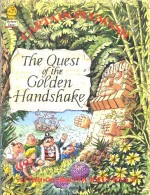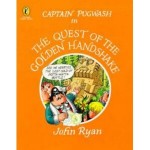

By John Ryan (Fontana Picture Lions/Puffin)
ISBN: 0-00-662253-4Â (Fontana 1985)Â Â 978-0-14055-486-1 (Puffin 1997)
Paperback: 32 pages
I recently reviewed an old John Ryan kid’s book and enjoyed it so much that I simply had to share another all-ages masterpiece with you…
John Ryan was an artist and storyteller who straddled three distinct disciplines of graphic narrative, with equal qualitative if not financial success.
The son of a diplomat, Ryan was born in Edinburgh on March 4th 1921, served in Burma and India and, after attending the Regent Street Polytechnic (1946-48), took up a post as assistant Art Master at Harrow School from 1948 to 1955. It was during this time that he began contributing strips to Fulton Press publications.
On April 14th 1950 Britain’s grey, post-war gloom was partially lifted with the first issue of a new comic that literally gleamed with light and colour with which avid children were soon understandably enraptured; blown away by the gloss and dazzle of Dan Dare, Pilot of the Future, a charismatic star-turn venerated to this day and a host of other spectacularly illustrated stories strips and features.
The Eagle was a tabloid-sized paper with full colour inserts alternating with text and a range of various other comic features. “Tabloid†is a big page and one can get a lot of material onto each one. Deep within, on the bottom third of a monochrome page was an eight panel strip entitled ‘Captain Pugwash – The story of a Bad Buccaneer and the many Sticky Ends which nearly befell him’ delivered with dash and aplomb by John Ryan.
The indefatigable artist’s quirky, spiky style also lent itself to the numerous spot illustrations required throughout the comic every week and he also regularly produced ‘Lettice Leefe, the Greenest Girl in School’ for Eagle’s distaff companion comic Girl.
Pugwash, his harridan of a wife and the useless, lazy crew of the Black Pig ran until issue #19 when the feature disappeared.
This was no real hardship as Ryan had been writing and illustrating the incomparable and brilliantly mordant ‘Harris Tweed – Extra Special Agent’ a full page (tabloid, remember, upwards of twenty crammed and meticulously detail stuffed panels a page, per week) from The Eagle #16 onwards.
Tweed ran for three years as a full page until 1953 when it dropped to a half page strip and was repositioned as a purely comedic venture.
In 1956 the indefatigable old sea-dog (I’m referring to Horatio Pugwash, but it could so easily be Ryan: an unceasing story-peddler with a big family, he still found time to be head cartoonist at the Catholic Herald for four decades) made the jump to children’s picture books and animated features for television.
A Pirate Story was the first Pugwash chronicle (originally published by Bodley Head before switching to the children’s publishing specialist Puffin) and the first of a huge run of children’s books on a number of different subjects. Pugwash himself starred in 21 tomes; there were a dozen books based on the animated series Ark Stories, as well as Sir Prancelot and a number of other creations. Ryan worked whenever he wanted to in the comic world and eventually the books and the strips began to cross-fertilise.
When A Pirate Story was released in 1957 the BBC pounced on the property, commissioning Ryan to produce five-minute episodes (86 in all from 1957 to 1968, which were reformatted in full colour and rebroadcast in 1976). In the budding 1950s arena of animated television cartoons, Ryan developed a new system for producing cheap, high-quality animations to a tight deadline. Naturally he began with Pugwash, keeping the adventure milieu, but replaced the shrewish wife with a tried-and-true boy assistant. Tom the Cabin Boy is the only capable member of a crew which included such visual archetypes as Willy, Pirate Baranabas and Master Mate (fat, thin and tall – all dim) instantly affirming to the rapt, young audience that grown-ups are fools and kids do, in fact, rule.
Ryan also drew a weekly Pugwash strip in the Radio Times for eight years, before going on to produce a number of other animated series including Mary, Mungo and Midge, The Friendly Giant and Sir Prancelot as well as adaptations of some of his many children’s books. In 1997 an all new CGI-based Pugwash animated TV series began.
John Ryan returned to pirate life in the 1980s, drawing three new Pugwash storybooks: The Secret of the San Fiasco, The Battle of Bunkum Bay and today’s riot of scurvy delights The Quest of the Golden Handshake…
There was even a thematic prequel in Admiral Fatso Fitzpugwash, in which it is revealed that the not-so-salty seadog had a medieval ancestor who became First Sea Lord, despite being terrified of water…
In the Golden Handshake the Querulous Captain finds a genuine treasure map at an auction but a bidding war with nefarious nemesis Cut-Throat Jake turns into a full-blown riot in which the coveted chart is torn in half.
Never knowingly daunted, Pugwash and company steal Jake’s half of the map that night but on returning to the safety of the Black Pig are horrified to discover that their rival has had the same idea…
Luckily the brilliant cabin boy had anticipated the move and has already copied their portion of the priceless document. Heartened and enraptured by thoughts of vast wealth, the crew hastily set sail for South America, determined to plunder the Lost Treasure of the Stinkas…
However Jake is a brilliant rogue and smuggles himself and two burly accomplices aboard, planning to let Pugwash do all the heavy lifting and await his moment to claim his revenge and the gold…
Packed with in-jokes, glorious tom-foolery and daring adventure, the voyage to the New World in a “haunted†ship culminates in a splendid battle of half-wits before Tom, as usual, saves the day in his quiet, competent and deucedly clever way…
The first Pugwash was very traditional in format with blocks of text and single illustrations that illuminated a particular moment. But by 1982 the entire affair became a lavishly painted comic strip, with as many as eight panels per page, with standard word balloons. A fitting circularity to his careers and a nice treat for us old-fashioned comic drones.
The most recent edition of A Pirate Story (2008 from Frances Lincoln Children’s Books) came with a free audio CD, and just in case I’ve tempted you beyond endurance here’s a full list (I think) of the good(?) Captain’s exploits: Captain Pugwash: A Pirate Story (1957), Pugwash Aloft (1960), Pugwash and the Ghost Ship (1962), Pugwash in the Pacific (1963), Pugwash and the Sea Monster (1976), Captain Pugwash and the Ruby (1976), Captain Pugwash and the Treasure Chest (1976), Captain Pugwash and the New Ship (1976), Captain Pugwash and the Elephant (1976), The Captain Pugwash Cartoon Book (1977), Pugwash and the Buried Treasure (1980), Pugwash the Smuggler (1982), Captain Pugwash and the Fancy Dress Party (1982), Captain Pugwash and the Mutiny (1982), Pugwash and the Wreckers (1984), Pugwash and the Midnight Feast (1984), The Battle of Bunkum Bay (1985), The Quest of the Golden Handshake (1985), The Secret of the San Fiasco (1985), Captain Pugwash and the Pigwig (1991) and Captain Pugwash and the Huge Reward (1991), but quite frankly read any Pugwash pirate publication and you’ll be we’ll and truly hooked…
This magical, wry and enchantingly smart yarn is one of Ryan’s very best and long overdue for re-issue – as are they all – and a sure winner with fans of all ages if you can find it (talk about real buried treasures…).
We don’t have that many multi-discipline successes in comics, so why don’t you go and find out why we should celebrate one who did it all, did it first and did it well? Your kids will thank you and if you’ve any life left in your old and weary adult fan’s soul, you will too…
© 1984, 1997, 2012 John Ryan and presumably the Estate of John Ryan. All rights reserved.
